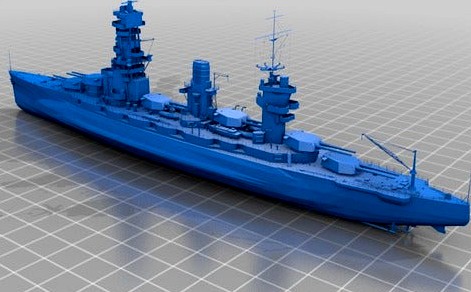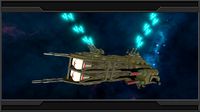Thingiverse

IJN Fusō class / Yamashiro by HatsuneR
by Thingiverse
Last crawled date: 3 years ago
Fusō (扶桑, a classical name for Japan) was the lead ship of the two Fusō-class dreadnought battleships built for the Imperial Japanese Navy. Launched in 1914 and commissioned in 1915, she initially patrolled off the coast of China, playing no part in World War I. In 1923, she assisted survivors of the Great Kantō earthquake.
Fusō was modernized in 1930–1935 and again in 1937–1941, with improvements to her armor and propulsion machinery and a rebuilt superstructure in the pagoda mast style. With only 14-inch (356 mm) guns, she was outclassed by other Japanese battleships at the beginning of World War II, and played auxiliary roles for most of the war.
Fusō was part of Vice-Admiral Shōji Nishimura's Southern Force at the Battle of Leyte Gulf. She was sunk in the early hours of 25 October 1944 by torpedoes and naval gunfire during the Battle of Surigao Strait. Some reports claimed that Fusō broke in half, and that both halves remained afloat and burning for an hour, but according to survivors' accounts, the ship sank after 40 minutes of flooding. Of the few dozen crewmen who escaped, only 10 survived to return to Japan.
Name: Fusō (Japanese: 扶桑)
Namesake: Classical name for Japan
Builder: Kure Naval Arsenal
Laid down: 11 March 1912
Launched: 28 March 1914
Commissioned: 8 November 1915
Struck: 31 August 1945
Fate: Sunk during the Battle of Surigao Strait, 25 October 1944
General characteristics (as built)
Class and type: Fusō-class battleship
Displacement:
29,330 long tons (29,800 t) (standard)
35,900 long tons (36,500 t) (full load)
Length:
192.024 meters (630.00 ft) (p.p.)
205.13 meters (673.0 ft) (o.a.)
Beam: 28.65 meters (94.0 ft)
Draft: 8.69 meters (28 ft 6 in)
Installed power:
40,000 shp (30,000 kW)
24 × Miyahara water-tube boilers
Propulsion:
4 × shafts
2 × Brown-Curtis steam turbine sets
Speed: 23 knots (43 km/h; 26 mph)
Range: 8,000 nmi (15,000 km; 9,200 mi) at 14 knots (26 km/h; 16 mph)
Complement: 1,198
Armament:
6 × twin 356 mm (14 in) guns
16 × single 152 mm (6 in) guns
6 × submerged 533 mm (21 in) torpedo tubes
Armor:
Belt: 305 mm (12 in)
Deck: 32–51 mm (1.3–2.0 in)
Barbettes: 203–305 mm (8.0–12.0 in)
Turrets: 228.6 to 279 mm (9.0 to 11.0 in)
Conning Tower: 351 mm (13.8 in)
General characteristics (1944)
Displacement: 34,700 long tons (35,300 t)
Length: 212.75 m (698.0 ft) (o.a.)
Beam: 33.1 m (108 ft 7 in)
Draft: 9.69 m (31 ft 9 in)
Installed power:
75,000 shp (56,000 kW)
6 × water-tube boilers
Propulsion: 4 × steam turbines
Speed: 24.5 knots (45.4 km/h; 28.2 mph)
Range: 11,800 nmi (21,900 km; 13,600 mi) at 16 knots (30 km/h; 18 mph)
Complement: approximately 1,900
Sensors and
processing systems:
1 × Type 21 air search radar
2 × Type 13 early warning radar
2 × Type 22 surface search radar
Armament:
6 × twin 356 mm guns
14 × single 152 mm guns
4 × twin 127 mm (5 in) dual-purpose guns
8 × triple, 6 × twin, 23 × single 25 mm (1 in) AA guns
Armor: Deck: 152–51 mm (6–2 in)
Aircraft carried: 3 × floatplanes
Aviation facilities: 1 × catapult
Fusō was modernized in 1930–1935 and again in 1937–1941, with improvements to her armor and propulsion machinery and a rebuilt superstructure in the pagoda mast style. With only 14-inch (356 mm) guns, she was outclassed by other Japanese battleships at the beginning of World War II, and played auxiliary roles for most of the war.
Fusō was part of Vice-Admiral Shōji Nishimura's Southern Force at the Battle of Leyte Gulf. She was sunk in the early hours of 25 October 1944 by torpedoes and naval gunfire during the Battle of Surigao Strait. Some reports claimed that Fusō broke in half, and that both halves remained afloat and burning for an hour, but according to survivors' accounts, the ship sank after 40 minutes of flooding. Of the few dozen crewmen who escaped, only 10 survived to return to Japan.
Name: Fusō (Japanese: 扶桑)
Namesake: Classical name for Japan
Builder: Kure Naval Arsenal
Laid down: 11 March 1912
Launched: 28 March 1914
Commissioned: 8 November 1915
Struck: 31 August 1945
Fate: Sunk during the Battle of Surigao Strait, 25 October 1944
General characteristics (as built)
Class and type: Fusō-class battleship
Displacement:
29,330 long tons (29,800 t) (standard)
35,900 long tons (36,500 t) (full load)
Length:
192.024 meters (630.00 ft) (p.p.)
205.13 meters (673.0 ft) (o.a.)
Beam: 28.65 meters (94.0 ft)
Draft: 8.69 meters (28 ft 6 in)
Installed power:
40,000 shp (30,000 kW)
24 × Miyahara water-tube boilers
Propulsion:
4 × shafts
2 × Brown-Curtis steam turbine sets
Speed: 23 knots (43 km/h; 26 mph)
Range: 8,000 nmi (15,000 km; 9,200 mi) at 14 knots (26 km/h; 16 mph)
Complement: 1,198
Armament:
6 × twin 356 mm (14 in) guns
16 × single 152 mm (6 in) guns
6 × submerged 533 mm (21 in) torpedo tubes
Armor:
Belt: 305 mm (12 in)
Deck: 32–51 mm (1.3–2.0 in)
Barbettes: 203–305 mm (8.0–12.0 in)
Turrets: 228.6 to 279 mm (9.0 to 11.0 in)
Conning Tower: 351 mm (13.8 in)
General characteristics (1944)
Displacement: 34,700 long tons (35,300 t)
Length: 212.75 m (698.0 ft) (o.a.)
Beam: 33.1 m (108 ft 7 in)
Draft: 9.69 m (31 ft 9 in)
Installed power:
75,000 shp (56,000 kW)
6 × water-tube boilers
Propulsion: 4 × steam turbines
Speed: 24.5 knots (45.4 km/h; 28.2 mph)
Range: 11,800 nmi (21,900 km; 13,600 mi) at 16 knots (30 km/h; 18 mph)
Complement: approximately 1,900
Sensors and
processing systems:
1 × Type 21 air search radar
2 × Type 13 early warning radar
2 × Type 22 surface search radar
Armament:
6 × twin 356 mm guns
14 × single 152 mm guns
4 × twin 127 mm (5 in) dual-purpose guns
8 × triple, 6 × twin, 23 × single 25 mm (1 in) AA guns
Armor: Deck: 152–51 mm (6–2 in)
Aircraft carried: 3 × floatplanes
Aviation facilities: 1 × catapult
Similar models
thingiverse
free

AM Class by HatsuneR
...6 anti-aircraft guns
aircraft carried: 2 × aichi m6a seiran floatplane
aviation facilities: 1 × catapult
scale: 1:350/ 322mm
cg_trader
$21

kilic class corvette
...essing systems:
mw-08 3d search radar
sting-eo fire control radar
scout/kh1007 navigation radar
electronic warfare
& decoys:
grabcad
free

USS Stallion (Skipjack class)
...es (bow)
24 × mark 37 torpedoes, mark 14 torpedoes, mark 16 torpedoes, mark 45 astor nuclear torpedoes, and/or mark 48 torpedoes.
thingiverse
free

IJN Kongō by HatsuneR
...hened +101 mm on ammo storage, +76 mm on engine room)
turrets: 9 in (230 mm)
barbettes: 10 in (250 mm)
belt: 8–11 in (200–280 mm)
thingiverse
free

IJN Shinano (Yamato Class) by HatsuneR
...m (4.7 in) aa rocket launchers
armor:
waterline belt: 160–400 mm (6.3–15.7 in)
flight deck: 75 mm (3.0 in)
aircraft carried: 47
thingiverse
free

Surcouf (N N 3) French by HatsuneR
...ed: 1 × besson mb.411 floatplane
aviation facilities: hangar
desingt by: keltos01 / convert from silent hunter by: hatsuner.
3dwarehouse
free

Adelaide class frigate
... melara; 1 × 20 mm mk 15 vulcan phalanx; 2 x triple 324 mm mk 32 torpedo tubes #adelaide #australian #class #frigate #navy #royal
cg_trader
$16

Cheng Kung-class frigate
...); 2 × auxiliary propulsion units, 350 hp (.25 mw)
speed over 29 knots (54 km/h)
complement 235
sensors and
processing systems
cg_trader
$22

HMS K4
...rgaming vessel history u boat submarine navy sea military vehicle military vehicle military watercraft military vehicle navy ship
cg_trader
$18

Alvaro de Bazan Class fregate
...nar
thales scout navigation radar
2 × raytheon spg-62 mk99 radar illuminator
aegis combat system
electronic warfare
& decoys:
Yamashiro
thingiverse
free

Hyper X Cloud Alpha S desktop stand by Yamashiro
...oint of view).
the screw is exactly the same as jpagesbri thing.
printed without supports but may need some for rounded features.
thingiverse
free

Dagoma DiscoEasy200 Réglage Z chariot X by Yamashiro
... ±2mm de réglage z.
il faut imprimer un adaptateur par coté.
il faut aussi par coté :
une vis m3-16
une m3-10
un ecrou m3 nylstop
thingiverse
free

DiscoEasy 200 Tendeur de courroie Y intégrée support plateau by Yamashiro
...en bleu ciel, la face de la courroie comportant les crans. donc pas de probleme de sens des stries sur les pièces du tendeur. :-)
thingiverse
free

Dagoma Discoeasy200 plateau réglable by Tonykaige
...jjj en y incorporant le tendeur du plateau à yamashiro voici les liens pour les details et explication.https://www.thingiverse.com/thing:2116147https://www.thingiverse.com/thing:2402497 -support...
3dwarehouse
free

Yamashiro
...yamashiro
3dwarehouse
imperial japanese navy project #battleship #ijn #ww2
3dwarehouse
free

Yamatokori Yamashiro Otemon
...yamatokori yamashiro otemon
3dwarehouse
#yamashiro #yamatokori #otemon #castle #japan
3dwarehouse
free

Yamato-gun Yamashiro East Tower
...yamato-gun yamashiro east tower
3dwarehouse
#castle #japan #yamato #yamashiro
3dwarehouse
free

Yamatokori Yamashiro Castle Ruins Hall
...yamatokori yamashiro castle ruins hall
3dwarehouse
#castle #japan #yamashiro #yamatokori
3dwarehouse
free

WW2 IMPERIAL JAPANESE NAVY IJN BATTLESHIP YAMASHIRO BB
...ww2 imperial japanese navy ijn battleship yamashiro bb
3dwarehouse
ww2 imperial japanese navy ijn battleship yamashiro bb
Hatsuner
3d_export
$15

Hatsune Miku vocaloid
...hatsune miku vocaloid
3dexport
3d character vocaloid hatsune miku
turbosquid
free

Hatsune Miku
... available on turbo squid, the world's leading provider of digital 3d models for visualization, films, television, and games.
3ddd
$1

Miku Hatsune
...i detailed 3d model.
previews rendered with mentalray.
feel free to leave your opinion in comments and check out my other models.
thingiverse
free

Miku Hatsune by alexgian
...miku hatsune by alexgian
thingiverse
world is mine version of miku hatsune
thingiverse
free

Hatsune girl by
...hatsune girl by
thingiverse
fox girl
thingiverse
free

Hatsune Miku Bookmark by LZZ
...hatsune miku bookmark by lzz
thingiverse
hatsune miku bookmark.
thingiverse
free

Hatsune Miku stencil 3 by Longquang
...hatsune miku stencil 3 by longquang
thingiverse
hatsune miku
free3d
free

Hatsune Miku
...hatsune miku
free3d
i get with left 4 dead and i converter to fbx, enjoy the model.
thingiverse
free

Ship propeller by HatsuneR
...ship propeller by hatsuner
thingiverse
ship propeller for: kongō class
thingiverse
free

Hatsune Miku by Milhause
...hatsune miku by milhause
thingiverse
hatsume miku is popular vocaloid
i recommend you sla or dlp printer for this print
Ijn
3d_export
$25

IJN Mikuma 1939
...ijn mikuma 1939
3dexport
cg_studio
$150

Japanese Battleship Yamato3d model
...yamato battleship vessel ship boat class yamato-class imperial navy ijn wwii world war ii naval artillery warship vray .fbx...
3d_export
$120

akagi iiww carrier
...related kaga figured prominently in the development of the ijn#39;s new carrier striking force doctrine that grouped carriers together,...
thingiverse
free

IJN Yamamto by Jkeat5
...wn as ijn yamamto. please note this is spelled wrong, and this is 10 inches long, so please change it to your most favorite size.
thingiverse
free

IJN AKI 1911 by JohnButtery
...bines rather than reciprocating piston engines. different boiler room arrangements required a third funnel. model is 1:1200 scale
thingiverse
free

IJN Ise by LaWRenceft
...lawrenceft
thingiverse
the hybrid japanese battleship ise. it took me 6 days too make. please like and follow if you liked it ;)
thingiverse
free

Victory at sea IJN Card Box by Ythor
...victory at sea ijn card box by ythor
thingiverse
free3d
free

IJN Battleship Nagato
...fficult part. feel free to use this model for any noncommercial purpose.(just write my id at the credit, that's all i want!)
3dcadbrowser
free

IJN Kaga Aircraft Carrier
...software.this 3d object can be downloaded in .max, .obj, .3ds, .fbx, .dxf, .lwo, .stl, .wrl, .ma, .dae, .x and .asc file formats.
thingiverse
free

IJN Satsuma 1910 by JohnButtery
...del of the imperial japanese navy semi-dreadnought satsuma, launched in 1910. equipped with 4 x 12 inch gun and 12 x 10 inch gun.
Class
3d_export
free

Class room
...class room
3dexport
class room 3d model
3ddd
free

Capellini / Class
...capellini / class
3ddd
capellini
стул class фирмы capellini
3ddd
free

Valmori - Class
...valmori - class
3ddd
valmori
bed from valmori model class
3ddd
$1

LUCECREA CLASS
...lucecrea class
3ddd
lucecrea class
торшер фабрики lucecrea class_коллекция
bakara contract_art.376351 da a
turbosquid
$15

BaikaL class Frigate and UraL class Corvette
... available on turbo squid, the world's leading provider of digital 3d models for visualization, films, television, and games.
3ddd
$1

vibieffe class armchair
...vibieffe class armchair
3ddd
vibieffe
vibieffe class armchair
3ddd
$1

Baccarat Glass Class
...
источник:http://www.select-interiormarket.com/en/baccarat-glass-class-chair-2601025-philippe-starck
текстуры имеются
turbosquid
$85

Class Brooklyn
...alty free 3d model class brooklyn for download as jpg and max on turbosquid: 3d models for games, architecture, videos. (1461215)
3d_export
$5

class room
...class room
3dexport
turbosquid
$69

Mercedes Class
...d model mercedes class for download as 3ds, obj, c4d, and fbx on turbosquid: 3d models for games, architecture, videos. (1440493)
